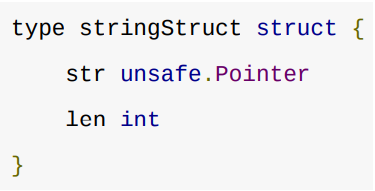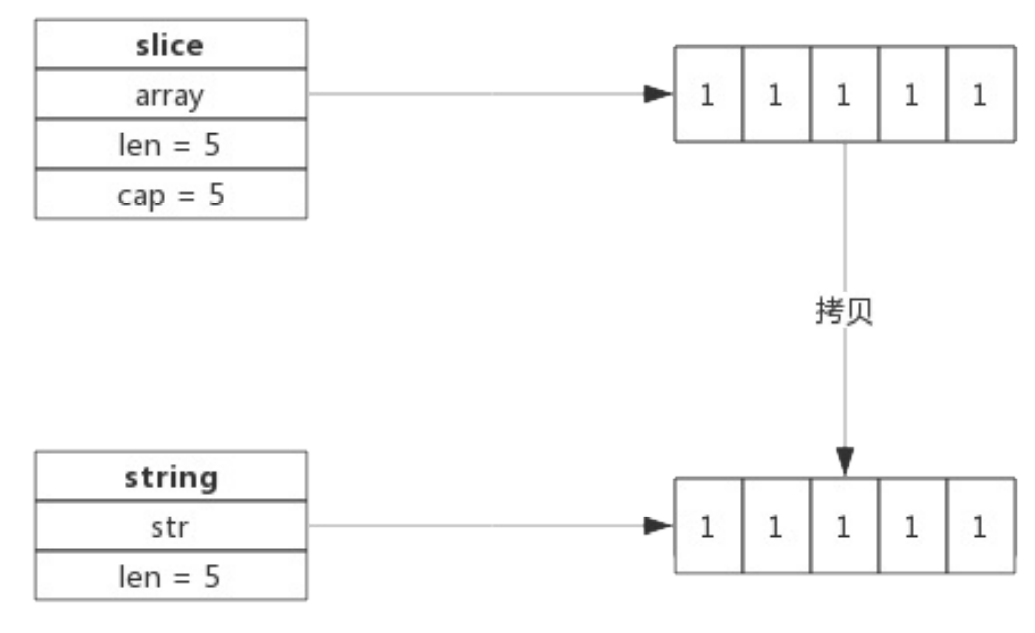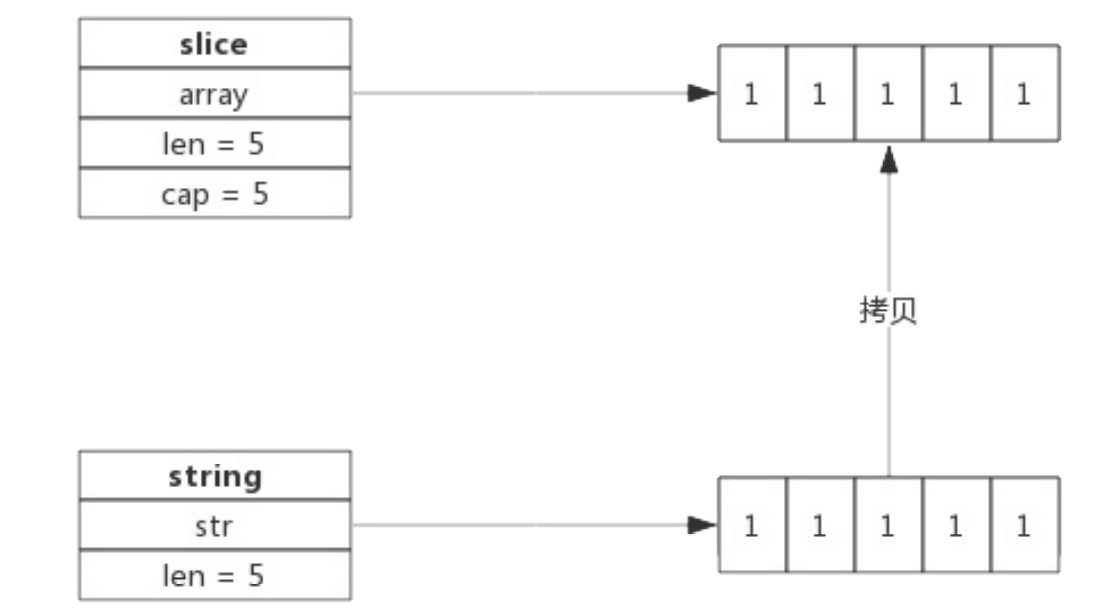String
The go standard library builtin defines all built-in types. The source code is located in Src / builtin / builtin go

- string is a collection of 8-bit bytes
- Usually, but not necessarily, UTF-8 encoded text.
- In addition, two important points were mentioned:
- string can be null (length 0), but not nil
- string object cannot be modified
data structure

-
tringStruct.str: the first address of the string
-
stringStruct.len: length of string
-
It is similar to slicing, except that slicing also has a member representing capacity
-
In fact, string and slice, to be exact, byte slice are often converted
string operation
statement
// As shown in the following code, you can declare a string variable to give the initial value
var str string
str = "Hello World"
// The process of string construction is to construct stringStruct according to the string, and then convert it into string
// The source code of the conversion is as follows:
import "unsafe"
func gostringnocopy(str *byte) string {
// Building a string from a string address
ss := stringStruct{str: unsafe.Pointer(str), len: findnull(str)}
// Construct stringStruct first
s := *(*string)(unsafe.Pointer(&ss))
// Then convert stringStruct to string
return s
}
- string
- In the runtime package is stringStruct
- External rendering is called string
[] byte to string
func GetStringBySlice(s []byte) string {
return string(s)
}
- This conversion requires a memory copy
- The conversion process is as follows:
- Apply for memory space according to the length of the slice
- Suppose the memory address is p and the slice length is len(b)
- Build string
- (string.str = p;string.len = len;)
- Copy data (copy the data in the slice to the newly applied memory space)
- Apply for memory space according to the length of the slice
Example diagram of conversion:

string to [] byte
func GetSliceByString(str string) []byte {
return []byte(str)
}
- A memory copy is also required
- The process is as follows:
- Request slice memory space
- Copy string to slice
Schematic diagram of conversion:

String splicing
// Strings can be easily spliced, as follows: str := "Str1" + "Str2" + "Str3"
- Even if a lot of strings need to be spliced, the performance is guaranteed
- Because the memory space of the new string is allocated at one time
- Therefore, the performance consumption is mainly on copying data
- A string of concatenated statements
- At compile time, it is stored in a slice
- The splicing process needs to traverse the slices twice
- The first traversal obtains the total string length and applies for memory accordingly
- The second iteration copies the strings one by one.
// String splicing pseudocode is as follows:
func concatstring(a []string) string {
// Total string length after splicing
length := 0
for _, str := range a {
length += length(str)
}
// Generates a string of the specified size, returns a string and a slice, and both share memory space
s, b := rawstring(length)
for _, str := range a {
// string cannot be modified. It can only be modified by slicing
copy(b, str)
b = b[len(str):]
}
return s
}
// Because string s cannot be modified directly
// So here we use the rawstring() method to initialize a string of a specified size
// A slice is returned at the same time, and they share the same memory space
// Later, the data is copied to the slice, which indirectly modifies the string
// The source code of rawstring() is as follows:
// Generate a new string, and the returned string and slice share the same space
func rawstring(size int) (s string, b []byte) {
p := mallocgc(uintptr(size), nil, false)
stringStructOf(&s).str = p
stringStructOf(&s).len = size
*(*slice)(unsafe.Pointer(&b)) = slice{p, size, size}
return
}
Why does the string not support modification?
-
Like string in C + + language, it has memory space, and modifying string is supported
-
But in the implementation of Go
-
string contains no memory space, only a pointer to memory
- The advantage is that string s become very lightweight
- It can be easily transmitted
- Don't worry about memory copies
-
A string usually points to a string literal
- The string literal storage location is a read-only segment, not on the heap or stack
- That's why there is a convention that string cannot be modified
-
Will converting [] byte to string copy memory?
- When byte slice is converted to string
- Instead of copying memory, a string is returned directly
- The pointer (string.str) points to the memory of the slice.
- For example, the compiler will recognize the following temporary scenarios:
- Use m[string(b)] to find the map (map is string as key, and slice B is temporarily converted into string)
- String splicing, such as "<" + "string(b)" + ">"
- String comparison: string(b) = = "foo"
- Because the byte slice is temporarily converted into a string, the string reference failure caused by changing the byte slice into a string can be avoided. Therefore, it is not necessary to copy the memory to create a new string at this time
How to choose between string and [] byte
Due to their different data structures, their derived methods are also different, which should be selected according to the actual application scenario
-
string is good at scenes
- Scenarios requiring string comparison
- Scenarios that do not require nil strings
-
[] byte is good at scenes
- The scene of modifying the string, especially when the modification granularity is 1 byte;
- The return value of the function needs to be expressed in nil;
- Scenes requiring slicing operation;
-
Although string is not applicable to as many scenarios as [] byte
- However, because the string is intuitive, it still exists in a large number in practical applications
- In the low-level implementation, [] byte is used more